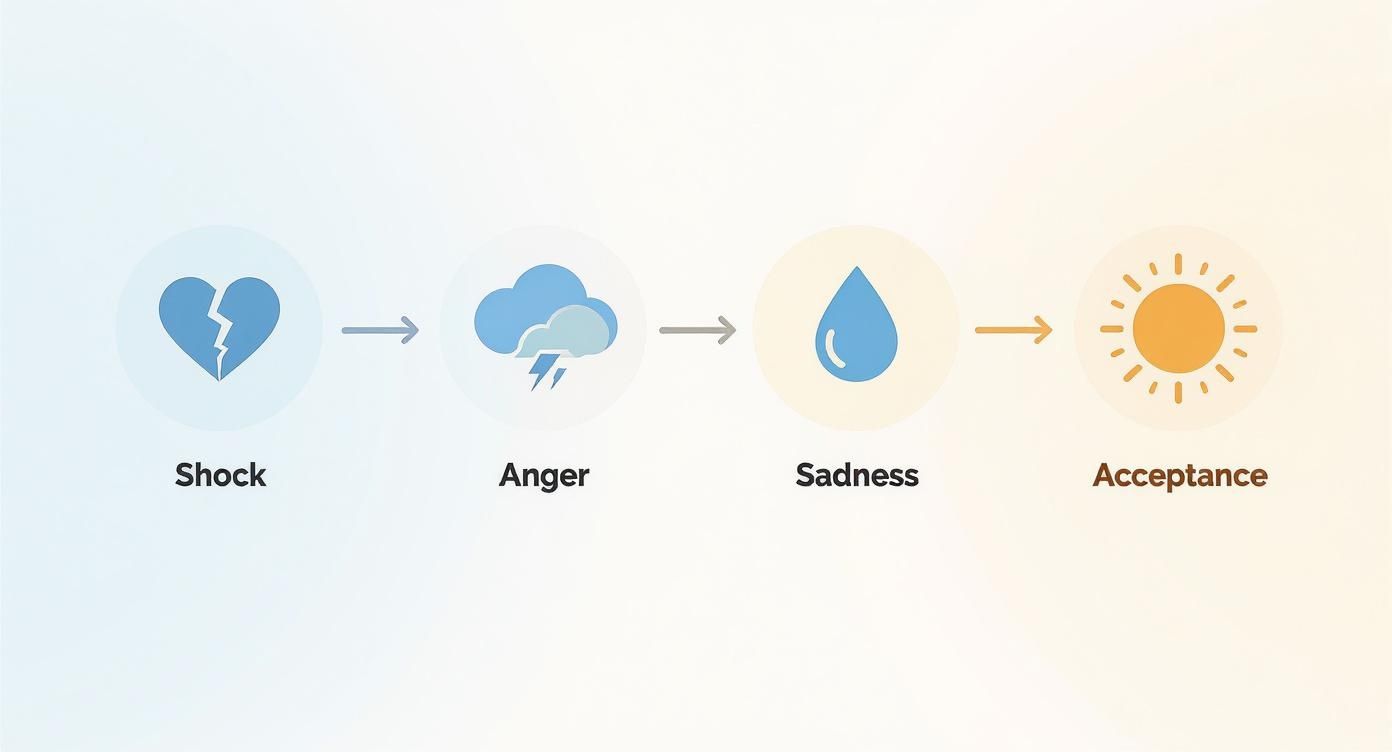When a relationship ends, it often feels like you've been dropped into an emotional storm with no map. But there's a predictable pattern to the chaos, a series of post breakup stages that almost everyone goes through. Think of it as a journey from the initial shock all the way to eventual acceptance.
Knowing what these stages are doesn't make the pain disappear, but it can make you feel a little less lost and a lot more in control as you start to heal.
Navigating the Emotional Seasons of a Breakup
I like to think of the heart as moving through seasons after a breakup. First comes the icy shock of winter, then the stormy anger of spring, followed by the deep, rainy sadness of summer, and finally, the clear, crisp air of autumn acceptance.
Framing it this way helps you see each stage as a natural—and temporary—part of the healing process.
Here’s why this perspective is so helpful:
- It helps you recognize that what you're feeling is normal, which allows for more self-compassion.
- You can track your own progress, so those really bad days don't feel so permanent.
- It lets you use specific coping strategies that actually work for the stage you're in right now.
The timeline below gives you a visual of how these emotional seasons flow, starting with a cracked heart and slowly moving toward a warming sun.

As you can see, the initial numbness eventually gives way to a swell of intense emotions before things start to level out. It’s a great reminder that acceptance isn’t a switch you can just flip; it's more like a gradual sunrise.
“Healing isn’t linear, but each phase plants seeds for growth.”
Your Seasonal Guide to Healing
Thinking of each emotional wave as a season can be incredibly comforting. It reminds you that even the harshest winter eventually gives way to the warmth of spring. This mindset fosters patience and reinforces the truth that no feeling lasts forever.
Here’s how to apply it:
- Winter (Shock): This is when you feel numb or can't believe it's real. Acknowledge that you're in the "winter" phase.
- Spring (Storms): Notice the moments of intense anger. Find safe ways to let those "storms" out.
- Summer (Rain): Recognize the deep sadness for what it is—grief. Let the "rain" fall and allow yourself to mourn the loss.
- Autumn (Sunshine): Celebrate the small wins and moments of peace as the "sunshine" of acceptance breaking through the clouds.
Next Steps on Your Healing Journey
If you're ready to dig deeper and find practical ways to move forward, our guide on recovery after breakup is packed with actionable steps.
A crucial first step in navigating any of these stages is understanding your emotions and developing coping strategies. The better you know your own emotional landscape, the easier it becomes to find your way.
As you start moving forward, remember that each emotion you feel is preparing you for the next chapter.
- Create a simple self-care routine to bring some stability to your daily mood.
- Schedule regular check-ins with friends, family, or a support group. You don't have to do this alone.
- Take a few minutes each week to reflect on your progress and tweak your coping methods.
“Every step you take, no matter how small, moves you closer to emotional clarity.”
Healing is a mix of looking back to understand and taking action to move forward. It’s about blending acceptance with intentional growth.
Embrace each stage for what it is: another step on the path toward rediscovering yourself. Keep going.
The First Stage of Shock and Denial
It feels like the world just slammed on the brakes. One minute, you were part of a "we," and the next, you're just… not. This is the first stop on the breakup journey, and it's defined by a thick, disorienting fog of shock and denial.
Your brain isn't being dramatic; it's protecting you. Think of it like an emotional circuit breaker. The reality of the breakup is too much voltage to handle all at once, so your mind flips the switch, plunging you into a state of numbness. This isn’t a flaw or a weakness. It’s a powerful, primal instinct to self-preserve, buying you precious time to slowly start processing what just happened.

What Shock and Denial Looks Like
During this initial phase, your feelings and actions can feel completely out of sync. You might feel strangely detached, like you're watching a movie about someone else's life. You go through the motions—work, eat, sleep—but none of it feels real.
Some other classic signs of this stage include:
- The Phone Vigil: You’re constantly checking your phone, half-expecting a text that says, "I made a huge mistake."
- The Mental Replay: That final conversation plays on a relentless loop in your head. You dissect every word, searching for a different ending that isn't there.
- Clinging to False Hope: You convince yourself this is just a big fight. You'll cool off, they'll come to their senses, and things will be back to normal by next week.
- A Sense of Unreality: Everything feels dreamlike or surreal, as if you’re walking through a slightly distorted version of your own life.
This stage is your mind's emotional cushioning. It's a temporary shield from the raw, jagged edges of the pain, giving you just enough stability to get through those first few hours and days.
How to Ground Yourself During This Stage
Denial is a totally normal and necessary part of grieving, but you can't live there forever. Staying stuck will only delay your healing. The goal isn't to rip the Band-Aid off and feel everything at once, but to gently, carefully reintroduce reality. This is all about surviving the initial tidal wave without doing something impulsive you'll regret later.
Focus on small, manageable steps that help you regain a tiny bit of control:
- Set a Temporary No-Contact Rule: Even if it’s just for 72 hours, this creates critical space. It breaks the cycle of checking your phone and allows you to hear your own thoughts without their influence muddying the waters.
- Lean on a Trusted Friend: Find that one person who will listen without judgment but also won't feed your denial. A good friend can be the anchor to reality you desperately need when your own perspective is completely skewed.
- Practice Simple Grounding Exercises: When your mind starts spinning, bring yourself back to the present. Name five things you can see in the room. Name four things you can physically feel. This simple mindfulness trick yanks you out of those painful thought loops and plants you firmly back in the here and now.
2. Working Through Anger and Bargaining
Once the initial shock wears off, the emotional dam holding everything back tends to break. This next phase is often a flood of intense, chaotic feelings, usually dominated by anger and bargaining—two powerful reactions that show your mind is finally starting to grapple with the reality of what you've lost.
Anger is a totally normal response to feeling hurt, abandoned, or treated unfairly. It’s a protective emotion, one that rises up to defend your heart. You can think of it as your emotional immune system kicking into overdrive. This fiery energy isn’t something you should just stuff down; it’s something to understand and use productively.
Understanding the Role of Anger
The trick is to learn the difference between anger that helps you heal and anger that just keeps you stuck in a painful loop. Destructive anger is what leads to sending those late-night texts you instantly regret or lashing out at mutual friends. Constructive anger, on the other hand, can be an incredible motivator for positive change and for learning how to stand up for yourself.
It's also interesting to see how this pain can show up differently for men and women. A huge study on romantic breakups surveyed 5,705 people across 96 countries and found that women tend to report higher levels of immediate emotional pain, averaging 6.84 out of 10. Men, on the other hand, averaged 6.58. You can dive deeper into the full study about breakup pain gender differences on exboyfriendrecovery.com.
So, what are some healthy ways to deal with this anger?
- Intense Physical Exercise: Channel that raw energy into something physical. Go for a hard run, tackle a high-intensity workout, or even just punch a pillow. A physical release can work wonders.
- Journaling: Write down everything you're feeling without censoring a single word. Getting those swirling thoughts out of your head and onto paper is incredibly freeing.
- Speaking with a Professional: A therapist can offer a safe, non-judgmental space to unpack where that anger is coming from and help you build healthy ways to cope.
Anger, when you manage it right, is the fuel that can rocket you out of despair and toward self-empowerment. It’s a sign that you value yourself and know you deserved better.
Escaping the Bargaining Loop
Right alongside anger, you’ll probably run into its frustrating cousin: bargaining. This is the stage of endless "what ifs" and "if onlys." It’s your brain’s desperate attempt to hit the rewind button and get a different outcome. You might find yourself mentally negotiating with your ex, with the universe, or even with yourself.
This sounds a lot like:
- "If only I had been more patient, we’d still be together."
- "Maybe if I just text them, they’ll realize what they’re missing."
- "I swear I'll change if we can just try one more time."
These thoughts are just painful mental traps that keep you chained to a past you can’t change. The best way to break free is to gently but firmly redirect your focus. When the thought pops up, acknowledge it without judgment—"Ah, there’s that thought again"—and then intentionally shift your energy to an act of self-care. Make a cup of tea. Go for a walk around the block. Put on your favorite song.
This simple practice slowly retrains your brain to stop obsessing over the past and start focusing on the present—and on your own healing.
Coping with Sadness and Depression
Once the fiery heat of anger starts to cool, you're left with what is often the longest, toughest part of the breakup journey. This is the stage where the true weight of the loss really settles in, bringing a deep, heavy sadness that can feel like it’s swallowing you whole.
It's like the storm has finally passed, but now you’re standing in the quiet, gray aftermath, looking at the wreckage. This phase is defined by loneliness, despair, and a constant, dull ache for what you once had. The first step to getting through it is simply allowing yourself to feel that pain.

Recognizing What This Stage Looks and Feels Like
During this phase, it’s completely normal to feel a whole host of emotional and physical symptoms as your mind and body process the grief. Remember, you aren't just getting over a person—you're mourning a future you thought you'd have.
Some of the most common signs that you're in the depression stage include:
- Frequent Crying: Tears can feel like they're on a hair trigger, coming at unexpected moments. This is a healthy, natural release.
- Loss of Interest: Hobbies and activities that used to bring you joy might suddenly feel pointless or like too much effort.
- Changes in Sleep or Appetite: You might find yourself sleeping all the time or barely at all. The same goes for eating—you could lose your appetite completely or find yourself overeating.
- Feelings of Emptiness: A persistent feeling of being hollowed out or hopeless is a trademark of this stage.
When you're in this headspace, simple things like falling asleep can feel impossible. Exploring some practical strategies to calm anxiety at night can be a huge help in getting some much-needed rest.
It's crucial to understand the difference between the deep sadness that comes with grieving a relationship and clinical depression, which requires professional support.
Signs of the Depression Stage vs. Healthy Grieving
This table can help you tell the difference between the normal, intense sadness of a breakup and signs that might point to something more serious.
| Behavior/Symptom | Healthy Grieving | Potential Indicator of Clinical Depression |
|---|---|---|
| Duration of Mood | Sadness comes in waves; you can still experience moments of joy or relief. | Persistent low mood for 2+ weeks with little to no break. |
| Self-Esteem | You might feel rejected or lonely, but your core sense of self-worth remains. | Feelings of worthlessness, intense self-blame, and hopelessness. |
| Daily Functioning | You may struggle, but you can generally manage work, school, and basic self-care. | Significant impairment in daily life; unable to get out of bed or complete simple tasks. |
| Social Withdrawal | You might isolate yourself but still accept support from close friends or family. | Complete withdrawal from all social contact and activities. |
| Thoughts of the Future | You have difficulty imagining a happy future, but the thought still seems possible. | A pervasive belief that things will never get better. |
If your symptoms align more with the right-hand column and have been going on for a few weeks, please consider reaching out to a therapist or counselor. There is no shame in getting help.
Building Resilience with Self-Compassion
Getting through this isn't about "sucking it up" or forcing yourself to move on. It's about treating yourself with the same kindness you'd give to a friend who's hurting.
The goal here is to focus on small, gentle steps that help you build back your strength, one day at a time.
- Create a Simple Daily Routine: When your inner world feels chaotic, a little bit of outer structure can be a lifesaver. Simple goals—make the bed, take a 10-minute walk, eat lunch at noon—can make a world of difference.
- Engage in Small Comforts: Don't put pressure on yourself to feel happy. Just aim for comfort. That could mean listening to a calming playlist, wrapping up in your softest blanket, or re-watching a movie you know by heart.
- Practice Self-Compassion: Acknowledge your pain without judging it. Tell yourself, "It's okay that I'm not okay right now." Healing is a process, and it takes as long as it takes.
These small acts of self-care are the building blocks of your recovery. If you find your mind getting stuck in painful loops, our guide on how to stop thinking about an ex offers some more targeted techniques.
This stage is a necessary part of healing. Give yourself the grace to feel it all so you can truly move forward.
Finding Hope Through Acceptance
After riding the emotional rollercoaster of anger and navigating the dense fog of sadness, you'll start to notice the sky clearing up a bit. This next phase isn't about throwing a party because your relationship is over. Far from it. It's about quietly, calmly acknowledging that it is over. Acceptance is like the first light of dawn after a really long, tough night—you stop fighting what happened and start gently turning your attention to what's next.
This isn't a flip-the-switch moment. It’s a slow, gradual shift. One day, you might realize you made it through your entire workday without your ex even crossing your mind. Or you’ll hear that song—your song—and feel a soft wave of nostalgia instead of a sharp, stabbing pain. This is where the real healing begins to take root, allowing you to build a new life for yourself on solid ground.
The Subtle Signs of Acceptance
Unlike the loud, demanding emotions from the earlier post breakup stages, acceptance has a tendency to sneak up on you. You might not even recognize it at first. Think of it less as a destination you arrive at and more as a new way of being, marked by small but powerful shifts in how you see things and live your day-to-day.
You’ll know you’re getting there when you start noticing things like:
- More Good Days Than Bad: The emotional highs and lows begin to even out. You'll still have tough moments, but you'll find a more consistent sense of peace settling in.
- A Shift in Your Thoughts: When your ex does pop into your head, the thought is less about "what if we got back together?" and more about "what's next for me?"
- Renewed Curiosity: You start feeling that little flicker of excitement about your own future again—maybe you'll finally take that pottery class, reconnect with old friends, or plan a trip you've always dreamed of.
Acceptance is finally understanding that the breakup is just one chapter in your life story, not the whole book. It’s the moment you give yourself permission to start writing the next one.
How to Cultivate Acceptance and Look Forward
You don't have to just wait for this stage to happen; you can actively encourage it. This is your chance to move from just getting by to truly thriving by reconnecting with the most important person in your life: yourself. A powerful way to start is by simply rediscovering who you are outside of the partnership you just left.
It’s also worth remembering that the healing journey is unique for everyone. Research on emotional adjustment after breakups shows that things like how long and how good the relationship was can play a role in how long it takes to recover. People in longer, higher-quality relationships often reported more distress, while finding a new partner was linked to a quicker emotional rebound. You can dive deeper into these breakup recovery findings on wiley.com.
To strengthen your sense of self and nudge acceptance along, try these empowering moves:
- Rediscover Old Passions: What did you absolutely love doing before you were part of a "we"? Dust off that guitar, pick up that paintbrush, or finally join that hiking group you've been eyeing.
- Set a New Personal Goal: Give yourself something to look forward to that's all your own. Sign up for a 5k, commit to learning a new skill online, or start planning that solo adventure. Having a goal creates purpose and forward momentum.
- Reconnect with Your Identity: Grab a journal and make a list of your strengths, your core values, and the things you're passionate about. It sounds simple, but this little exercise is a powerful reminder of your own worth, helping you rebuild your self-esteem on your own terms.
Rebuilding and Redefining Your Life

Once you've made peace with the past through acceptance, you step into the most powerful phase of all the post breakup stages: transformation. This isn't just about getting back to "okay." It's about consciously building a new life—one that feels more like you, shaped by everything you've learned along the way.
Think of it like renovating an old house. The earlier stages were about clearing out the debris and gutting what no longer worked. Now, you get to be the architect of your own future, choosing the paint colors, furniture, and experiences that truly reflect the person you are today.
Designing Your New Life
This rebuilding phase is your chance to be intentional. You're consciously choosing friendships, hobbies, and goals that align with your core values—the parts of yourself that might have been collecting dust during the relationship. The focus finally shifts from healing old wounds to getting excited about what's next.
This is your time for pure self-discovery and exploration. What have you always wanted to do? Who have you been meaning to reconnect with?
- Cultivate New Friendships: Join a local hiking club, take that pottery class you've been eyeing, or find a group that shares your interests. Bringing new people into your life introduces fresh energy and perspectives.
- Invest in Personal Growth: Learn that language, sign up for that coding course, or finally launch the side project you've been dreaming about.
- Explore New Experiences: Take a solo trip, even if it's just for a day. Trying new restaurants, hobbies, or just walking a different route home can rewire your brain for joy.
This stage is about turning the pain of your past into a powerful catalyst for positive, lasting change. It's where you realize the breakup didn't break you—it just broke you open.
The whole point is to build something stronger and more beautiful than what you had before. As you start to feel that confidence return, you might even start thinking about romance again. When you're ready, our guide on how to start dating again offers some thoughtful advice for stepping back out there. This final step completes the journey, taking you from heartbreak to a renewed, vibrant sense of self.
Have Questions? Let's Talk Through Them.
Going through the stages of a breakup can feel confusing and isolating, so it's only natural to have questions pop up along the way. When you're lost in that emotional fog, getting a little clarity can make all the difference.
How Long Does This Actually Take?
Honestly, there's no magic number or universal timeline for healing a broken heart. It's not like a cold that's gone in a week. Factors like how long you were together, how deep the connection was, and even your own personal attachment style all come into play.
Instead of staring at the calendar, try to measure your progress in smaller ways. Are you having more good days than bad ones? That's progress. Healing isn’t a race; it's the slow, steady process of untangling your life from someone else's.
Is It Normal to Bounce Between Stages?
Absolutely. In fact, it's more normal than not. The path to healing is rarely a straight line—it’s much more common to feel like you’re taking two steps forward and one step back. You might feel a real sense of acceptance one week, only to get blindsided by a wave of anger or deep sadness the next.
Think of the post-breakup stages less like a rigid staircase and more like a spiral. You might circle back to similar feelings, but each time you do, you're looking at them from a new vantage point, with a little more strength and perspective than before.
This back-and-forth movement is a completely normal part of processing a major loss. Don't beat yourself up for it.
How Do I Know When I’m Ready to Date Again?
You'll know you're ready when the idea of dating feels genuinely exciting, not like a chore or a desperate attempt to distract yourself. The real signal is emotional readiness, not just a need to fill the empty space your ex left behind.
Look for these signs in yourself:
- You're no longer secretly (or not-so-secretly) hoping your ex will come back.
- You feel genuinely whole and content on your own.
- The thought of meeting someone new is about building a connection, not proving you've "won" the breakup.
When you're dating because you want to share your already full life—not because you need someone to complete it—that's when you know you're truly ready.
At Poke Match, we're here to provide the guidance you need to build healthier, stronger connections. Explore our resources to help you navigate your journey with confidence. Learn more about how we can help.
